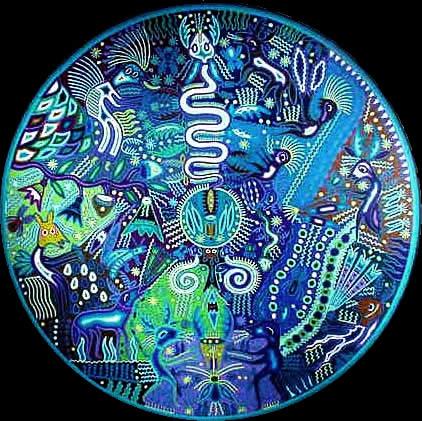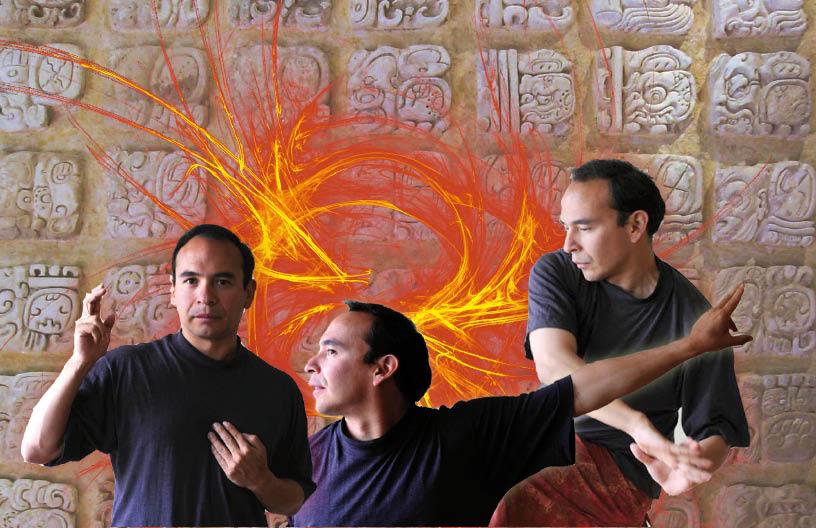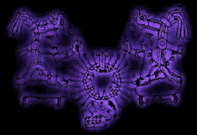- The Yok'Hah Maya Nahual tradition
- What is Nahual ?
- What is Yok'Hah ?
- The embodied Maya calendar
YOK'HAH
Several Mexican civilizations such as the Olmec, the
Teotihuacan, the Maya, the Zapotec, the Mixtec and the
Aztec contributed over thousands of years to develop a
body oriented integrative practice. This practice
consist in a series of dynamic postures, meditation in
motion including voice, accompanied with a particular
deep breathing. This discipline is called Yok'Hah and
it belongs to a certain line of the Mayan tradition.
The intention of Yok'Hah (not the goal the Nahual
does not have a goal and its purpose is the path
itself) is to re-discover the human core and to explore
and use it as an energy source of personal power: In
all freedom, purity, honesty and with all due
respect.
1 Etymology
YOK'HAH refers to traditional physical , mental und
spiritual discipline originated in Mexico by pre
Columbian Mesoamerican cultures around 7,000 years
BCE.
YOK'HAH is a compound of the proto Mayan (a language
thought to have been spoken at least 7,000 years ago)
words Yok and Hah, meaning “above”,
“transcendence” and “to settle
down”, “to strike roots”,
referring to the connection between a higher spiritual
state of mind and the physical awareness of
grounding.
Proto-Mayan is the hypothetical common ancestor of
the 30 living Mayan languages, as well as the extinct
Classic Maya language documented in the Maya
Hieroglyphical inscriptions.
It is important to consider that YOK'HAH is a
discipline, which is not related to yoga or any
oriental disciplines, although, some parallelism in
their principles can be found. The YOK'HAH practice
belongs to a complex natural based mythological Mexican
tradition, which knowledge was secretly delivered
through the centuries from one generation to
another.
2 Origins
The origins of YOK'HAH are uncertain, due to the
lack of literature and historical references. During
the invasion and conquest of Mexico by the Spaniards in
early 16th century, the Spanish Church and government
officials destroyed most of Mayan texts and codices in
which their knowledge was written and represent. Many
of the sculptures, constructions and reliefs were lost
as well. Nevertheless, indigenous people tried to
transmit their knowledge across generations without a
writing system through oral tradition, forming small
family groups in which their culture were kept by their
members and elders.
It has been considered that Yok`Hah was a result of
at least 7000 Years of progressive and chronological
development of different Mesoamerican cultures,
starting with the Olmec and Toltec, with some other
contributions from other societies such like Mixtec,
Zapotec, Aztec and Maya . In the historical and
mythical narratives of the Aztecs are referred the
heritage of their ancestors, the Toltec Civilization.
The anecdotes tell the story of the combat lifestyle of
the Toltec and their warrior culture. They developed a
system of practices and codes of training for combat,
linked to cosmogony and spiritual beliefs. This system
was in constant transformation and furthermore, this
art of warfare influenced other cultures. Mixtec,
Zapotec and Aztec lead to subsequently contributions
and developments. Some of these civilizations decayed
and perished, causing the partially lost of their
heritage.
There is no scientific probe which confirms or
denies the actual existence of the Toltec civilization,
causing polemic among Mesoamericanists, although in
some Mexican cultural traditions, they continue to
follow their life precepts, considering the
mythological narratives an art of living in itself.
The Maya was the last culture, which adapted the
discipline to it's own cosmogony and philosophy. Along
the millennia, this practice adopted a spiritual
character, transforming the original fighting style
into a form of dance and meditation in movement as a
discipline of body- mind -spiritual integration.

3 Concept
YOK'HAH is a holistic path, introducing the concept
of time in her spiritual discipline as a criteria or
maximal integration. She includes dynamical physical
postures, YOK'HAH Maya breathing, voice training and
meditation in movement.
YOK'HAH considers the human being to be a physical,
mental, spiritual and time unit.
Time component:
Time is seeing as an important feature and a
constitutive element of the human wholeness. Through
YOK'HAH energetic movements it is pretend to awake the
present time in the practitioners as a living force
coming from the energetic sources of the physical body.
In other words, practitioners learn to focus in their
“here and now” experiences, feelings,
emotions and perceptions.
Physical and mental components:
YOK'HAH Maya breathing enables the capacity of
experiencing deep breathing in different organizational
layers of the body. The integration of these functional
layers generates and regulates the complexity of body
fluids and chemical synapse encouraging specific
behaviors. YOK'HAH breathing, therefore, actually
influences four layers, three physically and one
psychological.
Psychologically layer works with the calming of the
mind through relaxation, body- synergy coordination and
meditation in movement in order to break behavioral
patterns of distress and to dissolve emotional
stagnation and blockages. This practice teaches how to
master the mind.
Spiritual component:
YOK'HAH emphasizes the importance of freeing the
energy stream through out the body in order to reach a
particular state of mind (called Nahual) reaching one's
soul and pursuing wisdom or enlightenment.
The purpose of this discipline is to create the
homeostasis between the different layers, human body
functions and the components of what is describe by the
YOK'HAH Maya Nahual Tradition as human: A unit of body,
mind, soul and time, bound together through an
energetic flow.
4 Breathing
YOK'HAH breathing
YOK'HAH Maya cellular breathing is called Qaaq nu
shib tan-kelem (Old- young fire). The aim of the
breathing technique is to reach and oxygenate every
cell of every organ and body part of the organism as a
whole.This develops a sharp body awareness. The
breathing technique expands strength chemical neural
synapse processes, influencing the central vestibular
system located in the cerebellum or main balance center
of the brain. The sensation of being grounded and in
balance is also due to cellular Mayan breathing and
physical, mind training as well.
At an energetic level, Quaq nu shib tan-kelem seeks
to activate the energetic flow from the organism
treating and undoing body psychological blockages.
5 Health benefits ascribed to YOK'HAH practice
The improvement of the body's physical health,
balance, sensation of grounding and clearness of mind,
are some of the benefits of the practice with YOK'HAH.
Some other advantages are the development of
psychomotoric coordination, neural muscular
flexibility, strength, stretch at body-mind levels,
velocity, resilience. Sense of well being; bright,
cheerful eyes and serenity of mind are among it?s
benefits.

6 YOK'HAH in modern times
Modern YOK'HAH belongs to a specific lineage of the
descendants of the Maya people, called YOK'HAH Maya
Nahual Tradition.
The knowledge of YOK'HAH has been preserved since
the process of culturization by the Spaniards in the
last five centuries by Maya and Zapotec descendants of
the Tehuantepec isthmus. As a result of the resistance
against the Conquistadores and subsequently Mexican war
of independence against the Spanish Crown at the
beginning of the 19th century, the new generations were
displaced, forcing to move and settle in the gulf
region of Oaxaca, where they live until the Mexican
revolution break out in 1910.
The elders and progeny then emigrated to Mexico City
where they continued teaching their knowledge within
their own clan. It's to take in consideration that the
teaching of YOK'HAH, like almost all surviving Mexican
cultural indigenous traditions, was maintained in
secret till the end of the 20th century.
I have practiced YOK'HAH since 1976, when I was 6
years old. In 1997 I started to teach YOK'HAH across
Europe.
|



